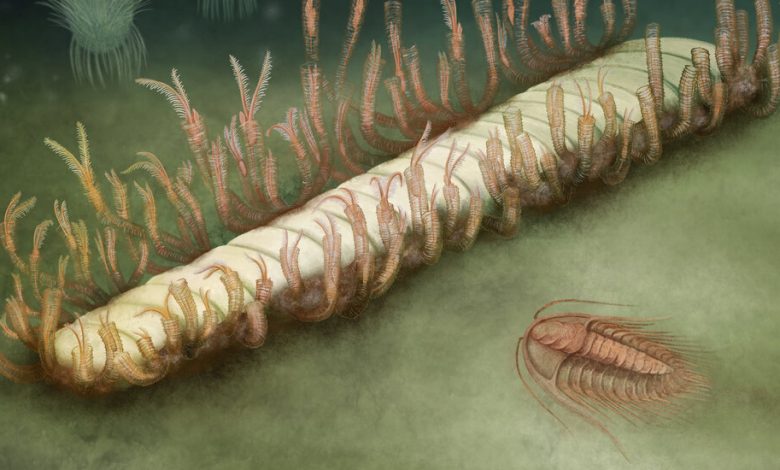Fossil Reveals Ancient Seafloor Communities

The bodies of the dead drift to the bottom of the ocean, where the bottom dwellers make use of them. They make temporary reefs from the bones of modern whales, and they did the same for their earlier relatives and Mesozoic seagoing reptiles.
Such recycling dates back to 530 million years ago, when complex animal life first appears in the rock. Yet as animal life diversified into the early Paleozoic era, the history of such interspecies interactions became harder to track.
In research published Wednesday in Communications Biology, however, a team of researchers describes a 480-million-year-old cephalopod from Morocco that was posthumously converted into a condominium: the earliest example of a relationship that goes back nearly a half-billion years.
The fossil arrived at Harvard in 2019, amid a collection of legally imported invertebrate fossils from the Fezouata Shale, a formation full of exquisitely preserved Ordovician fossils from the Atlas Mountains of Morocco.
The community of animals represents a transitionary period, said Karma Nanglu, a paleontologist at the Harvard Museum of Comparative Zoology and an author on the study. Preserved in the rocks are leftovers from the strange communities of the Cambrian era — full of trilobites and strange, free-swimming arthropods called radiodonts — and new arrivals from the Ordovician, when animal groups like mollusks moved high into the water column and grew significantly in size.
One of those mollusks, a straight-shelled nautiloid, died and drifted to the seafloor. By the time it was eventually covered by silt, the 1.5-inch shell had collected a tight tangle of 88 tubes, resembling a forest of little chimneys. These were the remnants of a colony of minuscule filter-feeders called pterobranchs, which use their feathery arms to pluck plankton out of the water column — and prefer to build on bits of dead animal.
“They’re really minute,” Dr. Nanglu said. “This bit of cephalopod skeleton would be the equivalent of a multistory building to a pterobranch.”
Planktonic graptolites, one branch of the family, were so abundant in the early Paleozoic period that their tiny fossils were used to help correlate ages of rocks, before vanishing 300 million years ago. But the tube-building side of the family still live unassuming lives on the seafloor, their larvae growing on any bits of hard-shelled animals they can find.
“They’ve been colonizing mollusk shells for half a billion years, and they’re still doing their thing in modern oceans,” Dr. Nanglu said. “Anything that can maintain the same lifestyle that long is worth paying attention to.”
Pterobranchs might have been at it for an unusually long time, but evidence of animals building their homes atop other animals has a remarkably deep fossil record. Some of the earliest examples appear 25 million years before the Fezouata specimen. In the Cambrian, tubes built by one species of giant worms hosted another, and brachiopods encrusted the bodies of free swimming arthropods like barnacles on modern whales.
“As soon as you’ve got large stuff swimming in the water column, things are looking for free rides,” Dr. Nanglu said. “And as soon as things are dying, you’ll see animals building their entire lives on top of what’s essentially a corpse. As soon as a resource makes itself available some animal will find a way to exploit that resource in short order.”
But while Cambrian deposits like the Burgess Shale preserve multiple examples of interactions between different species, similar sites from the following Ordovician period are much rarer, Dr. Nanglu said. Even sites like Fezouata, known for its diverse array of well-preserved invertebrates, rarely yield them. That makes the tube-encrusted cephalopod a tantalizing glimpse into a living ecosystem.
“It helps flesh out that these early animals are doing interesting things and engineering ecosystems themselves,” Dr. Nanglu said. “Sometimes we don’t just see it until we have a fossil like that.”




